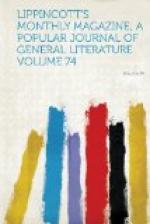But what pen can describe the splendor of this scene? what brush reproduce its ever-changing hues, its delicate mists, its broad shadows, the deep blue of the sea, the rosy tint which Aurora casts over all, or the vivid purples and crimsons which glow upon the mountain-crags and strew the indigo of the Mediterranean with jasper, ruby, Sapphire and gold when the sun falls to rest behind the beautiful Cape of Antibes? Nature defies Art in such a spot as this, and seems to triumph in bewildering our delighted senses with the infinite variety of her products. Here her sea and mountains are sublime in their grandeur, and at our feet are wild violets and heath and rosemary and thyme, each, too, sublime in its way. She defies us with her colors, her odors, and even with her music, for overhead “the lark at heaven’s gate sings,” and the bees go buzzing home laden with honey stolen from the wild honeysuckle, caper and myrtle which grow abundantly around.
It was my fortune once to escort to this view the illustrious French artist Paul Delaroche. His delight can be better imagined than described. “Ah!” he exclaimed, “ceci c’est trop bien!” He assured me that no painter could attempt it excepting perhaps Turner, and vowed that although he had visited many lands he had never witnessed anything to surpass it. Turner perhaps could have reproduced such a scene, for he possessed the power of giving the general effects of extended landscapes admirably, without entering too minutely into their details. In the “Loreto necklace” and “Golden bough” he has painted two marvelously varied views full of ranges of mountains, rivers, lakes and classic buildings, without confusion, and with great skill displayed in portraying various and vaporous distances.
But it is high time that we leave the fine arts and hasten on to Monaco. Space, like time, is limited, and much as I should love to conduct my readers all the long way on foot, to show them the monster olive tree at Beaulieu, which is seven yards in circumference, and reputed the largest of its species in the world, to pause a little amidst the Roman ruins of La Tarbia and the Saracenic remains of Eza and Roccabruna, I must hasten on to the capital of the Liliputian dominions of his Serene Highness Prince Florestan II.
Let me entertain you with a very brief account of the history of this singular little princedom. Monaco is one of the most ancient places in Europe. Five hundred years before our Blessed Lord came to redeem the world, Hecate of Melites wrote an account of the city, which he called Monoikos (the “isolated dwelling"), and declared it to be even then so old a town that the people had lost all tradition of its origin, except that some of their priests asserted Hercules to have founded it after his feat of slaying Geryon and the brigands before he left Italy for Spain. The Romans, in fact, called it Portus Herculis Monceci, and for short “Portus Monceci.”




